AP Biology Exam Review 2022
1/629
There's no tags or description
Looks like no tags are added yet.
Name | Mastery | Learn | Test | Matching | Spaced |
|---|
No study sessions yet.
630 Terms
What is a hydrogen bond?
a weak bond between two partially charged atoms
Where are hydrogen bonds found in water?
bonds between H in one water molecule and O in another water molecule)
Where are hydrogen bonds found in DNA?
between nitrogenous bases
How many hydrogen bonds are found between each complementary base pairing?
2 - Adenine + Thymine
3 - Guanine + Cytosine
What is the structure of an amino acid?
Amino group (N-terminus), Carboxyl group (right side), Side chain (R-group)
What are the three options for the R group?
polar, nonpolar, charged
For each R group option, describe the polarity and justify your response.
polar - hydrophilic
non polar - hydrophobic
charged - hydrophilic
What are three properties of water?
cohesion, adhesion, surface tension
Describe why water is considered a polar molecule?
due to the high electronegativity of oxygen in comparison to hydrogen, oxygen attracts more electrons, leaving an uneven distribution of charge in water molecule, making oxygen slightly negative and hydrogen slightly positive, making water a polar covalent molecule
How did hydrogen bonding allow for each property?
Water molecules are polar, so they form hydrogen bonds. This gives water unique properties, such as a relatively high boiling point, high specific heat, cohesion, adhesion, and density.
adhesion: capillarity, hydrogen bonds --> due to polarity can allow bonding with other polar substance
cohesion: hydrogen bonds between water molecules
high specific heat: takes more energy to break the bonds as water constantly makes and breaks
hydrogen bonds with the teacher
surface tension: cohesion creates a flat surface as
hydrogen bonds are holding water together
universal solute: due to its polarity
Using the properties of water, describe how water can move up a capillary tube to move from the roots to the
leaves in a plant.
adhesion: water sticking to the xylem
cohesion: as water evaporates, it gets pulled up the capillary tube as the cohesive bonds to other water molecules
Using the properties of water, describe how a water strider can walk on water.
surface tension: caused by cohesion (hydrophobic legs
What are the four macromolecules?
carbohydrates
lipids
proteins
nucleic acids
What are the elements found in a carbohydrate?
CHO
what are three functions of carbohydrates in living organisms?
- short term energy storage
- glycogen (cellular respiration)
- starch: energy storage in plants
- glycogen: energy storage in animals
- chitin: strengthens cell walls
What are the elements found in a protein?
CHONS
What are the functional groups found in all amino acids?
amino group (NH2)
carboxyl group (COOH)
R group (varies)
- non polar, polar, charged, basic/acidic
What are three functions of proteins in living organisms?
- enzymatic function in the body
- building blocks of tissues
- cell movement
- enzymes
- defensive
- receptors
- motor proteins
- cell movements
What are the elements of nucleic acids?
CHONP
What are parts found in all nucleotides?
- sugar phosphate backbone
- sugar (deoxyribose, ribose)
- nitrogenous base: A, T, C, G, U
What are three functions of nucleic acids in living organisms?
- DNA replication
- DNA expression (transcription/translation)
- heredity
What are the elements found in a lipid?
CHO (P)
How are the three different types of lipids different?
- triglycerides: glycerol + fatty acid tails
- phospholipid: phosphate group + 2 fatty acid tails
- steroids: cell membranes (cholesterol) required to synthesize hormones
What are three functions of lipids in living organisms?
- insulation
- hormone production
- cell membrane structure (phospholipid)
Which macromolecules contain nitrogen?
- proteins / nucleic acids
Which macromolecules contain phosphorus?
nucleic acids and phospholipids
Which macromolecules contain sulfur?
proteins
How does the R group affect the folding of a protein (include polar and non polar R groups)?
affects the interactions between amino acids (how they bond together to make polymers with the removal of water)
What is dehydration synthesis?
monomers bonded together with the removal of water (formation of sucrose)
Provide an example of dehydration synthesis?
(glucose + glucose to sucrose )
What is hydrolysis?
the breakdown of polymers to mongers through the addition of water
Provide an example of hydrolysis?
(sucrose to glucose + glucose)
What is the hydrolysis?
the chemical breakdown of a compound due to reaction with water.
what is the dehydration synthesis?
the process of joining two molecules, or compounds, together following the removal of water
What type of bond is found in carbohydrate?
Where are they located?
glycosides bonds (covalent)
between monomers
What type of bond is found between protein monomers?
Where is this bond located?
peptide bonds
between amino agoutis and carboxyl groups
What type of bond is found between nucleic acid monomers?
Where is this bond located?
hydrogen bonds
between complementary nitrogenous bases
What is the monomer of a carbohydrate?
Identify the components of the monomer.
monosaccharide
-hydrogen atoms
-hydroxyl group
- aldehyde / ketone group
What is the monomer of a protein?
Identify the components of the monomer.
amino acid
- R group
- amino group (NH2)
- carboxyl group (COOH)
What is the monomer of a nucleic acid?
identify the components of the monomer.
nucleotide
- sugar
- phosphorous
- nitrogenous bases
Identify the components of a phospholipid?
phosphate group
- hydrophilic heads
- 2 fatty acids tails - hydrophobic -
- carboxyl group
What type of bond is found in starch?
glycosidic bonds
What type of bond is found in cellulose?
glycosidic bonds / hydrogen bonds
Which bond can be broken by animals?
neither
Pentose Sugar in DNA
deoxyribose
Pentose Sugar in RNA
ribose
Nitrogenous Bases in DNA
adenine, guanine, cytosine, thymine
Nitrogenous in RNA
adenine guanine, cytosine, uracil
Strandedness in DNA
double stranded
Strandedness in RNA
single stranded
How does a saturated and unsaturated fatty acid differ?
How does the level of saturation affect the function of the lipid?
saturated: single bonds, solid at room temperature
unsaturated: double bonds, liquid at room temperature, kinks
saturation: affects fluidity of the membrane
more saturated: more solid
Describe how a non polar R group substitution changes the structure and function of a protein.
- polar substances attract, so the attraction would be gained
- change the shape in the presence of water, the amino acid would move towards the water, changing its shape
Describe how a cytosine to thyme substitution changes the structure and function of DNA
- CG -> CT
- the broth of the strand wouldn't necessarily change, but his error could lead in the mistranccription/mistranslation of in the DNA/RNA
- could change the function of the enzymes + alter the genetic information
Describe how a cytosine to guanine substitution changes the structure and function of DNA.
- CG
- GG
- breadth would change and the hereditary information could be altered. the c coach could be altered, leading to a mutation and change or inhibition of an enzyme
Describe how a deoxyribose to ribose changes the structure and function of a nucleic acid.
- changes to the ribose (DNA -> RNA)
- the bases would function except for thymine
- RNA - 1/2 stranded, deals with transcription/translation, making ribosomes/enzymes
Describe the structure of the nucleic acid polymer.
DNA
- 5' prime end
- phosphate group
- 3' hydroxyl group
- 2 strands
- A - T, C - G
- nucleotides, sugar phosphate, base
- double helix
RNA
- 1 strand
3' - 5'
- A - U, C - G
- ribose
What are the ends called and what is found at each end?
5' prime end (phosphate group)
3' hydroxyl group (stands grows at the 3' end)
Which end is the location of the growing nucleic acid strand?
3' end
What are the complementary base pairings found in nucleic acids?
adenine - thymine
cytosine - guanine
Identify the number of hydrogen bonds found between those two nitrogenous bases.
adenine - thymine (2)
cytosine - guanine (3)
primary structure of protein
types of bonds
sequence of amino acids
peptide bonds
secondary structure of protein
types of bonds
folding due to interactions of the atom backbone, alpha helix, beta pleated sheets
hydrogen bonds
tertiary structure of protein
types of bonds
interactions between R groups non covalent bonds
quaternary structure
types of bonds
multiple polypeptide chaines
hydrogen / weak bonds
What are the ends of a protein called and what is found at each end?
amino terminals (N terminus) - (NH2), (5' end)
carboxyl terminus (C terminus) - (COOH), (3' end)
Which end is the location of the growing polypeptide strand?
amino terminus (5' end)
Describe the structure of a carbohydrate
polysaccharides - cain of monosaccharide
linked together through glycosidic linkages
What are the components of a fat molecule?
glycerol + fatty acids - tryglyceride
What are the components of a phospholipid?
phosphate + carboxyl (hydrophilic) + 2 fatty acid tails (hydrophobic)
Describe the structure of a steroid.
steroid - 4 fused rings attached t chemical groups
What are the three components of DNA molecules?
- deoxyribose sugar
- phosphate group
- nitrogenous base
What are the three components of RNA molecules?
- ribose
- phosphate group
- nitrogenous base
DNA
(pentose sugar)
(nitrogenous base)
(strandedness)
(directionality)
- pentose sugar: deoxyribose
- nitrogenous base: adenine, guanine, cytosine, thymine
- strandedness: double
- directionality: 5' - 3'
RNA
(pentose sugar)
(nitrogenous base)
(strandedness)
(directionality)
- pentose sugar: ribose
- nitrogenous base: adenine, guanine, cytosine, uracil
- strandedness: single
- directionality: 3' - 5'
Ribosome
Cytoplasmic organelles at which proteins are synthesized.
What is the structure and function of the ribosome?
Ribosomes are made up of proteins + RNA (equal amounts)
2 sections (Subunits)
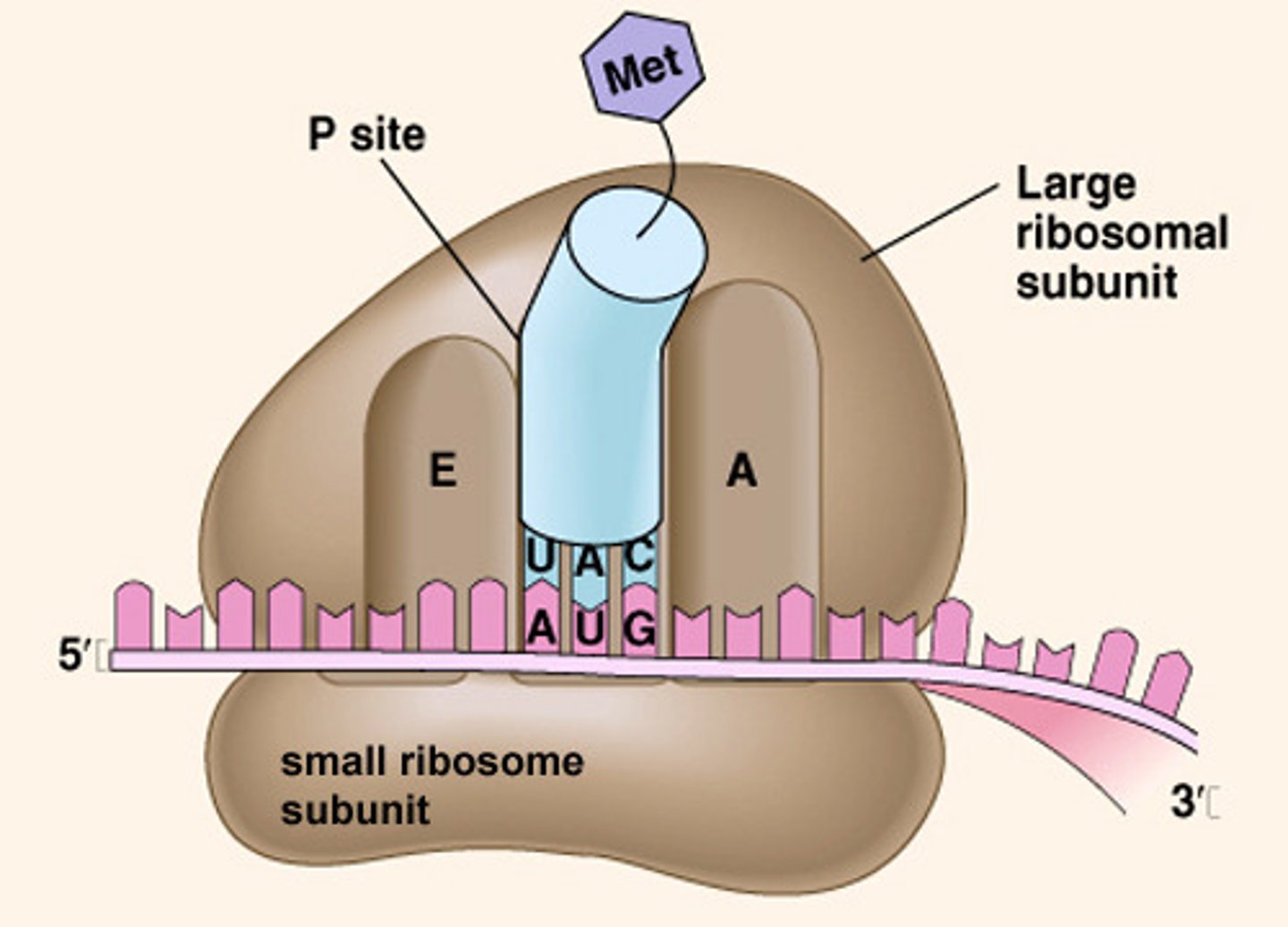
What are the three types of RNA involved in the structure or function of the ribosome?
rRNA - ribosomal RNA, ensure the proper alignment of mRNA and tRNA , and the ribosomes
tRNA carries the amino acid to the corresponding site on the protein synthesis chain base paring of codons between tRNA and mRNA that allows the correct amino acid to be inserted in the polypeptide chain
mRNA serves as the intermediary between RNA (transcription) and the synthesis of proteins during translation
How does the structure of the ribosome aid in the function?
smaller subunit - a place where mRNA binds + decodes, bigger subunit is the place the amino acids are included
their function - to synthesize proteins
How does the ribosome demonstrate a common ancestry of all known life?
ribosomes are present in all organisms, including prokaryotes
Endoplasmic reticulum
A cell structure that forms a maze of passageways in which proteins and other materials are carried from one part of the cell to another.
What is the structure and function of the rough ER?
continuous with the nucleus, a series of flattened sacs spanning across the cytoplasm
the function of the rough ER is to synthesize and expel proteins to the Golgi apparatus
How does the structure of the rough ER aid in the function?
because it is studded with ribosome, its able to facilitated the synthesis of proteins and it includes the transaction, essential for protein translation within the RER
What is the structure and function of the smooth ER?
meshwork of fine dislike tubular membranes vesicles, part of continuous membrane organelle within the cytoplasm of eukaryotic cells involved in the synthesis and storage of lipids
How does the structure of the smooth ER aid in the function?
tubules provide increased surface area devoted to the storage of enzymes
What is the relationship between the ribosome and the rough ER?
ribosomes facilitate protein synthesis, the main function of the RER (workers in a factor)
Golgi Bodies/Apparatus/Complex
A complex of stacked membranes involved in secretion and intracellular transport
What is the structure and function of the Golgi?
-The Golgi is made up of cisternae (stacked, flat, membranous sacks)
-When the cisternae are stacked in this way, the Golgi apparatus has a distinct polarity or sidedness. The cis ("on this side") surface is closest to the nucleus, and the trans ("across") surface is oriented toward the plasma membrane.
-The cis side of a Golgi apparatus receives the vesicles containing rough ER products, referred to as cargo, and the trans side ships them out to other organelles or the cell surface. As the cargo moves through the Golgi apparatus from the cis to trans surfaces, it is processed and packaged for delivery.
-"Mailroom of the cell"
-Site of the modification of proteins
How does the structure of the Golgi aid in the function?
the unique stacked structure gives the Golgi body the abilty to undergo its functions such as provide fluid transport of lipids / proteins throughout the cistarnae

Mitochondria
Powerhouse of the cell, organelle that is the site of ATP (energy) production
What is the structure and function of the mitochondria?
the mitochondria is a double - membraned organelle (inner and outer), with an inner membrane and mitochondrial matrix
the mitochondria is responsible for facilitating cellular respiration, the process which allows the mitochondria to Conert glucose, oxygen to CO2, ATP and H2O, providing ATP for reactions in the cell
How does the structure of the mitochondria aid in the function?
the inner / outer membrane provides the mitochondria with an enclosed space + high SA to compartmentalize the reactions and increase efficiency
Lysosome
cell organelle filled with enzymes needed to break down certain materials in the cell
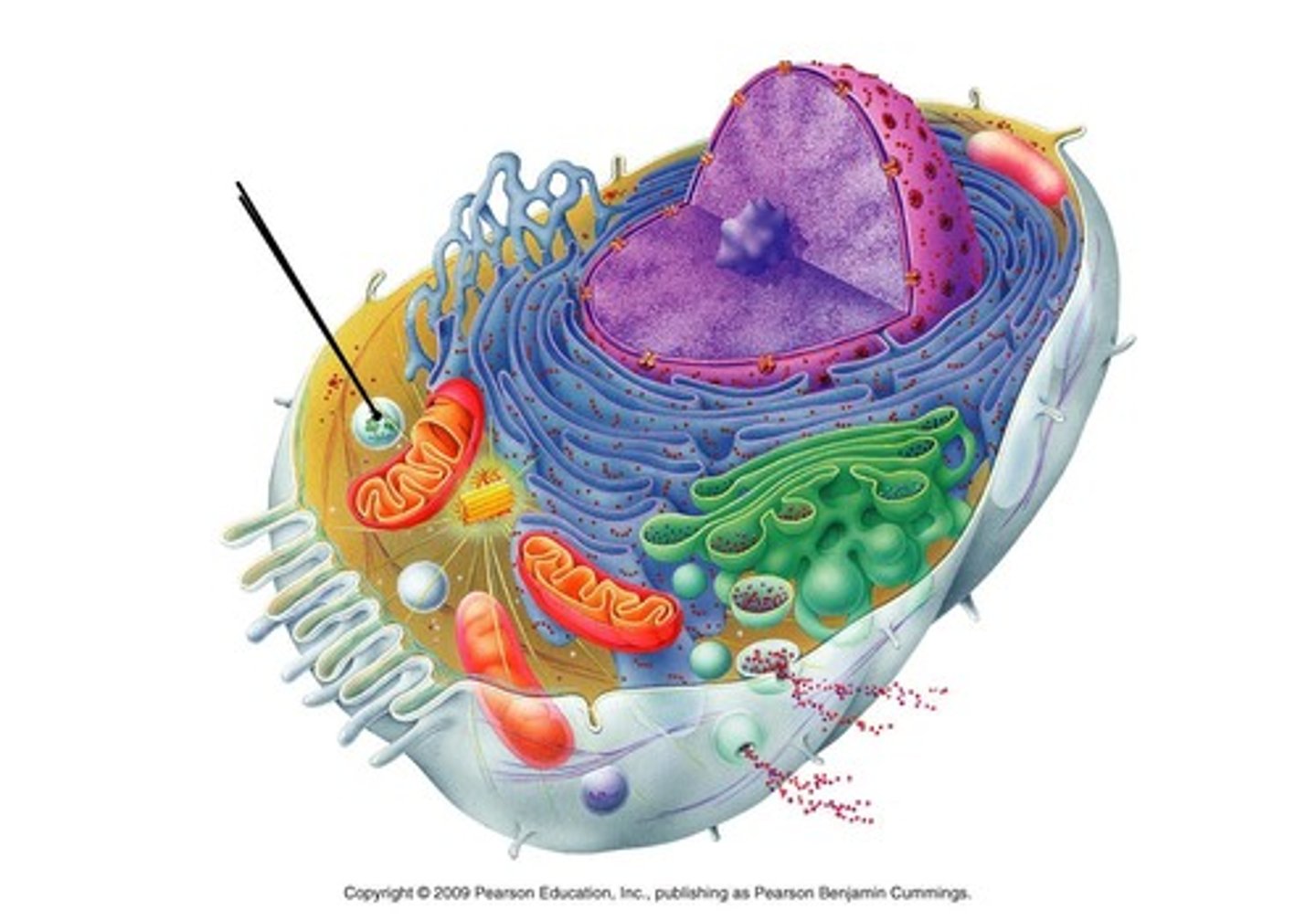
What is the structure and function of the lysosome?
the lysosome is a collection of enzymes surrounded by a single layer membrane
the function of lysosomes is to destroy viruses / bacteria and break down inoperable organelles and cellular debris
How does the structure of the lysosome aid in the function?
the membrane protects enzymes from leaking, the enzymes facilitate its function
Vacuoles
Cell organelle that stores materials such as water, salts, proteins, and carbohydrates
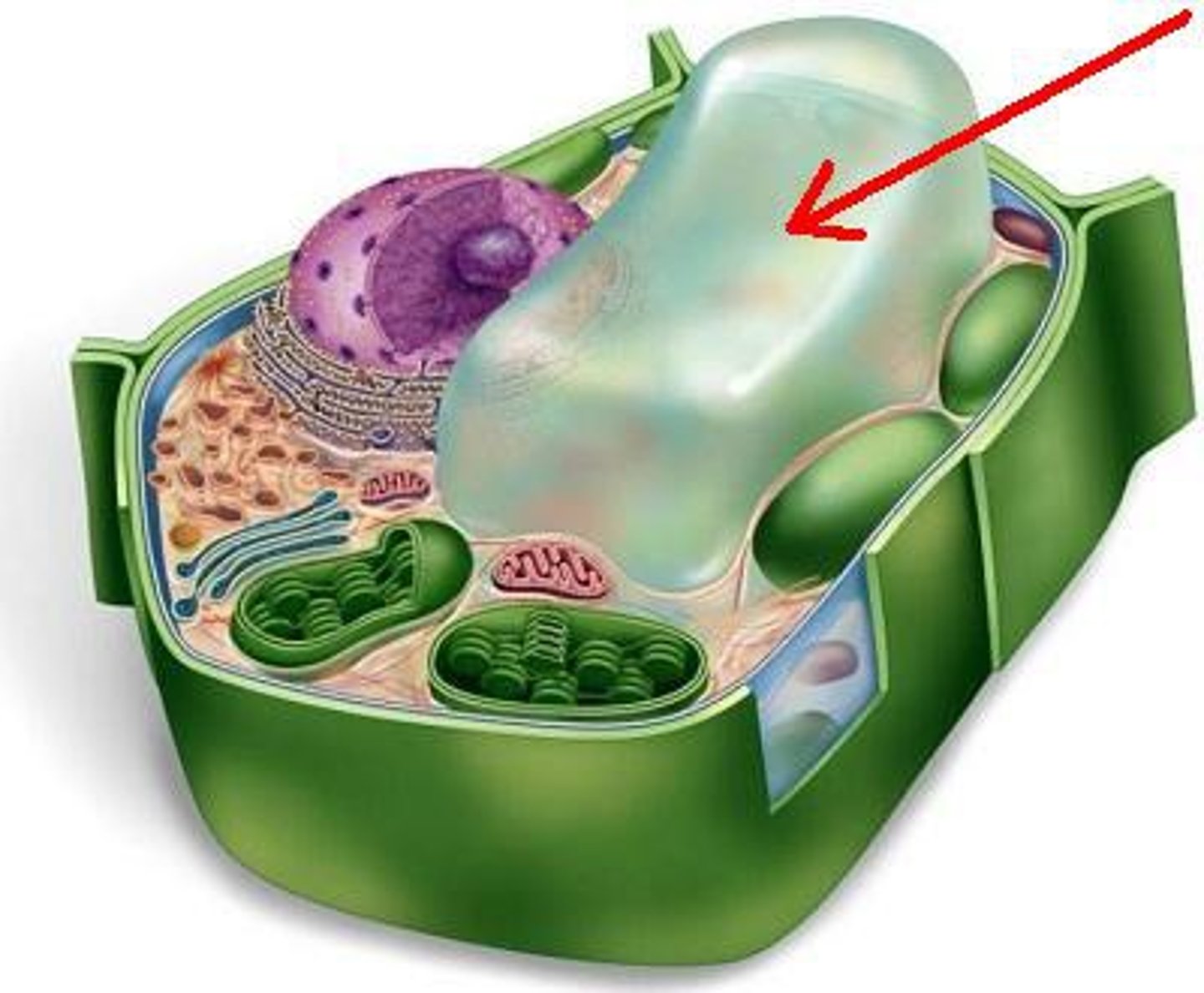
What is the structure of the vacuole?
membrane bound sac (mostly empty) filed with fluid and molecules they take in
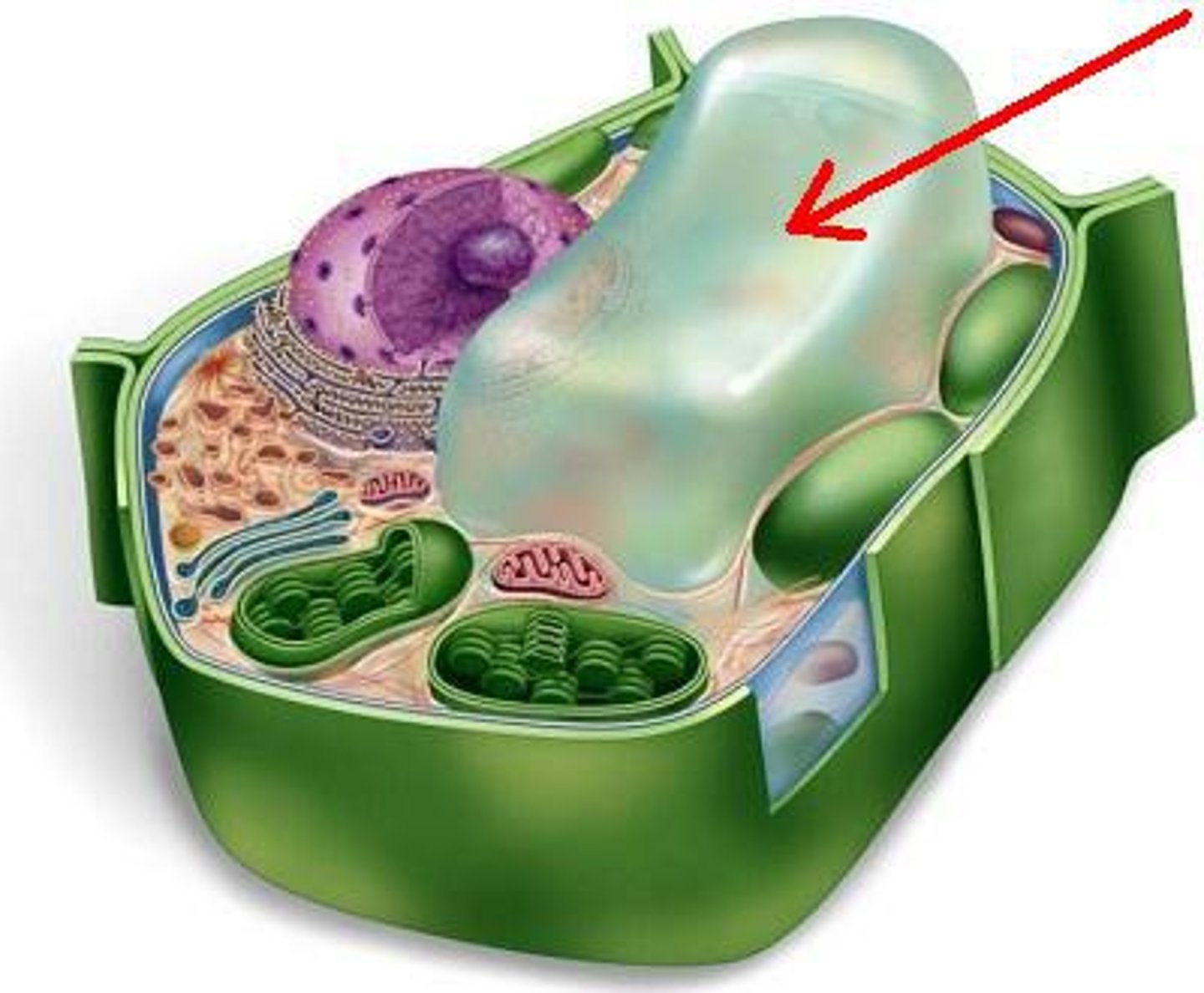
What is the function of the food vacuole?
encircle food particles when they enter the cell (mechanism the cell uses to "eat")
What is the function of the central vacuole?
Storing compounds produced by the cell
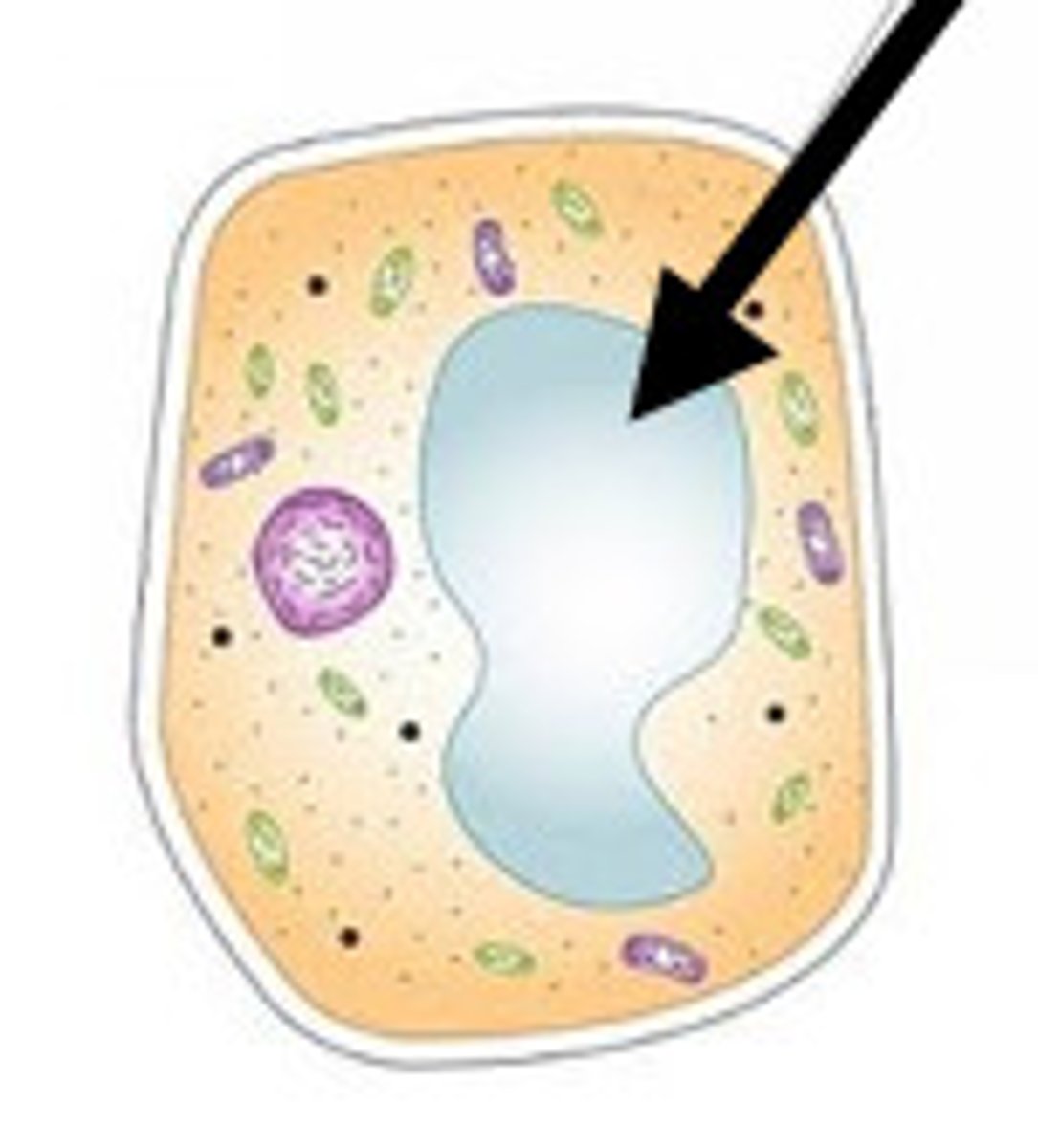
What is the function of the contractile vacuole?
It regulates the amount of water in the cell.
osmoregulation
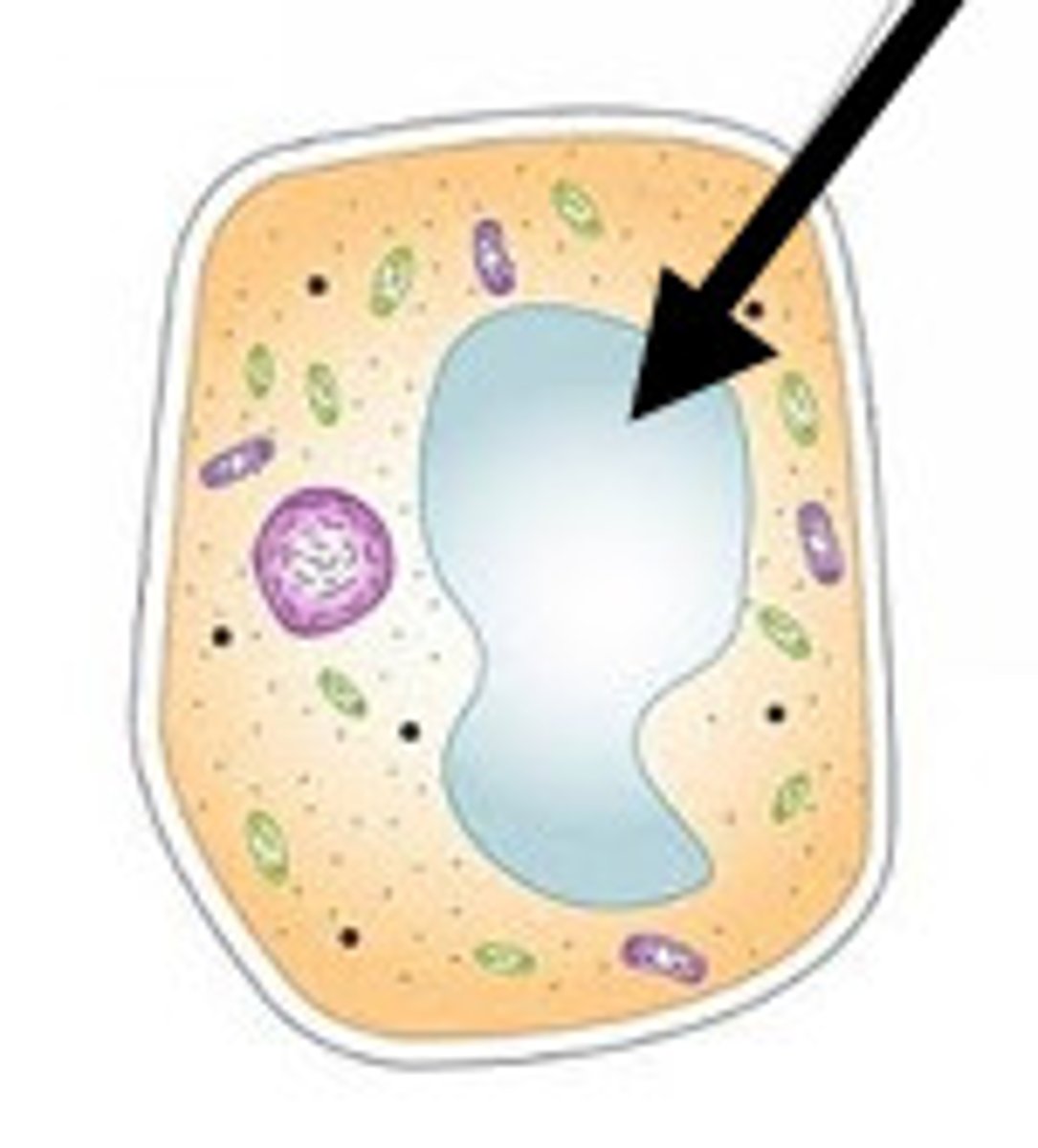
chloroplast
An organelle found in plant and algae cells where photosynthesis occurs
